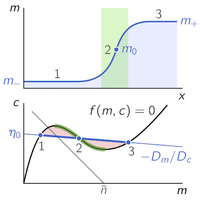Abstract
Experimental studies of protein-pattern formation have stimulated new interest in the dynamics of reaction-diffusion systems. However, a comprehensive theoretical understanding of the dynamics of such highly nonlinear, spatially extended systems is still missing. Here, we show how a description in phase space, which has proven invaluable in shaping our intuition about the dynamics of nonlinear ordinary differential equations, can be generalized to mass-conserving reaction-diffusion (MCRD) systems. We present a comprehensive analysis of two-component MCRD systems, which serve as paradigmatic minimal systems that encapsulate the core principles and concepts of the local equilibria theory introduced in the paper. The key insight underlying this theory is that shifting local (reactive) equilibria—controlled by the local total density—give rise to concentration gradients that drive diffusive redistribution of total density. We show how this dynamic interplay can be embedded in the phase plane of the reaction kinetics in terms of simple geometric objects: the reactive nullcline (line of reactive equilibria) and the diffusive flux-balance subspace. On this phase-space level, physical insight can be gained from geometric criteria and graphical constructions. The effects of nonlinearities on the global dynamics are simply encoded in the curved shape of the reactive nullcline. In particular, we show that the pattern-forming “Turing instability” in MCRD systems is a mass-redistribution instability and that the features and bifurcations of patterns can be characterized based on regional dispersion relations, associated to distinct spatial regions (plateaus and interfaces) of the patterns. In an extensive outlook section, we detail concrete approaches to generalize local equilibria theory in several directions, including systems with more than two components, weakly broken mass conservation, and active matter systems.
18 More- Received 7 September 2019
- Revised 7 July 2020
- Accepted 16 September 2020
DOI:https://doi.org/10.1103/PhysRevX.10.041036
Published by the American Physical Society under the terms of the Creative Commons Attribution 4.0 International license. Further distribution of this work must maintain attribution to the author(s) and the published article’s title, journal citation, and DOI.
Published by the American Physical Society
Physics Subject Headings (PhySH)
Popular Summary
Like birds that organize into flocks by interacting only with their immediate neighbors, proteins diffusing and interacting in cells can form self-organized patterns, which control essential processes like cell division and tissue-shape development. Experimentally, protein pattern formation has been studied in great detail in recent years. While theoretical descriptions dating back to Turing’s work in the early 1950s have focused on the dynamics of proteins near homogeneous steady states, work on fully developed patterns in the strongly nonlinear regime has mostly remained limited to numerical studies. Here, we present a novel theoretical framework that overcomes this limitation.
Our work focuses on reaction-diffusion systems, models that describe how chemical substances change in space and time, where the total amounts of these substances remain constant. The key insight is that changes in local densities shift local reactive equilibria, and thus induce concentration gradients which, in turn, drive diffusive redistribution of mass. We show how this dynamic interplay can be captured by simple geometric objects in the phase space of chemical concentrations. On this phase-space level, physical insight can be gained from geometric criteria and graphical constructions.
The fundamental elements of our theory are generalizable to a broad class of spatially extended nonequilibrium systems and pave the way toward an overarching theoretical framework. Furthermore, the framework suggests ways of experimentally characterizing pattern-forming systems at a mesoscopic scale, independently of biomolecular details, and provides tools that may help guide the design and control of self-organization.



